Poisonous Plants
Poisonous plants can cause serious injury to horses,particularly if animals graze when plants are at an especially dangerous growth stage, when little other forage is available, and when animals are very thirsty. Poisonings can be avoided by proper management of animals, pastures and hay.
Suggestions for preventing poisoning are as follows:
~Know which plants are poisonous and when they are potentially dangerous.
~Inspect pastures to identify and destroy poisonous plants before initiating grazing.
~Be sure animals are neither hungry nor thirsty when put on pasture or fed hay that might have poisonous plants.
~Buy hay locally so that unfamiliar and potentially poisonous plants are not fed and seeds are not introduced to your farm.
~Do not put animals on forage that is too young in springtime.
~Maintain grazing pressure appropriate for the pasture.
~Provide supplemental feed and water to animals during periods of low pasture availability.
Some of the most common poisonous plants are described here. This is not a complete listing, and other sources should be consulted if you are uncertain as to whether or not a plant could be toxic to your horse.
Herbaceous Plants
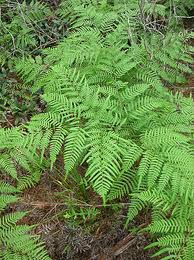
BRACKEN FERN (Pteridium aquilinum) - Bracken fern is probably the largest (up to six feet) and most common of the ferns in Ohio. It occurs in many habitats, including full sun, partial shade, woods, old pastures, and thickets. Unlike most ferns, bracken is less common in rich, moist, limey areas and thus is an indicator of poor soil. The tall, smooth, grooved stalk supports a large (three-feet long, three-feet wide) leaf equally divided into three parts, one terminal and two opposite. Each leaf blade is triangular, with oblong, pointed leaflets, and tight, narrow, blunt-tipped sub-leaflets. On fertile leaves the underside has a continuous line of sporangia around the leaf edge, covered by the overlapping margins. Bracken is one of the earliest ferns to appear in spring or after a fire. It sometimes forms large colonies of nearly solid stands, with the dark, green, leathery leaves bending nearly horizontal. In the fall, it is one of the first plants to be killed by frost, leaving large patches of crisp, brown foliage.
Horses eating large quantities of bracken fern show signs of acute poisoning related to vitamin B1 deficiency. Leaves as well as rhizomes are toxic. Poisoning is most common when other grazing is scarce, such as after periods of drought, or when bracken is a contaminant of hay. Symptoms usually appear two to four weeks after continuous grazing. Horses are particularly susceptible to bracken fern poisoning. Affected animals exhibit loss of condition and weight, incoordination, and a crouching position with feet apart and arched back. Bracken fern poisoning may be confused with other disorders, and other plants (field horsetail, turnip) can also induce symptoms related to B1 deficiency. Bracken fern can be suppressed or eliminated from pastures by improved pasture management that includes periodic close grazing or cutting and proper fertilization.
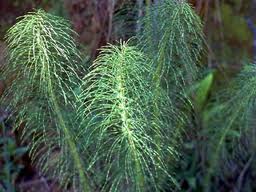 FIELD HORSETAIL (Equisetum arvense) – Field horsetail is the most common of several horsetails and it is also the most variable. This is a unique plant with two distinct growth forms (sterile and fertile stems), which often are not found together. The sterile stems are light green, highly branched, resembling a small pine tree. Stems are ascending and appear to be leafless; they may be perennial and evergreen, or annual, dying in autumn after frost. The stem has distinct joints or nodes, which bear tiny, black, scalelike leaves. The fertile stems are singular, tall, dark green, ridged, hollow, tubular, and distinctly jointed. Branches, when present, arise singly or in whorls at nodes. The stem terminates in a cone-shaped spore-bearing strobilus. The stem is rough like sandpaper due to impregnation with silica. The plant reproduces by spores or by deep, creeping rootstocks which sometimes bear tubers.
FIELD HORSETAIL (Equisetum arvense) – Field horsetail is the most common of several horsetails and it is also the most variable. This is a unique plant with two distinct growth forms (sterile and fertile stems), which often are not found together. The sterile stems are light green, highly branched, resembling a small pine tree. Stems are ascending and appear to be leafless; they may be perennial and evergreen, or annual, dying in autumn after frost. The stem has distinct joints or nodes, which bear tiny, black, scalelike leaves. The fertile stems are singular, tall, dark green, ridged, hollow, tubular, and distinctly jointed. Branches, when present, arise singly or in whorls at nodes. The stem terminates in a cone-shaped spore-bearing strobilus. The stem is rough like sandpaper due to impregnation with silica. The plant reproduces by spores or by deep, creeping rootstocks which sometimes bear tubers.
Field horsetail is found throughout Ohio along railways, field edges, woods, and waste areas. It seems to tolerate poor drainage and sandy or gravely areas. This weed is difficult to exterminate as it tolerates most herbicides. Field horsetail causes most trouble in hay fed to horses. Poisoning is similar to bracken fern poisoning; however, horsetail-poisoned animals maintain their appetites even after clinical signs appear. The poisoning is associated with thiaminase activity and thus vitamin B1 deficiency. Affected animals exhibit loss of condition, unthriftiness, excitability, staggering, and emaciation.
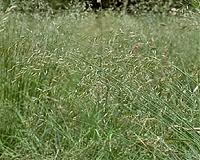 TALL FESCUE (Festuca arundinacea) – Tall fescue is probably the most widely adapted perennial pasture grass. It is a tall (up to five feet), tufted, deep-rooted plant that forms a coarse sod. Leaves are about one-quarter inch wide, with a ridged surface and fine, sharp, saw-toothed edges. The inflorescence is a compact panicle four- to 10-inches long. Although fescue poisoning is a condition of cattle, summer fescue toxicosis can affect horses during summer when grazing or fed tall fescue forage or seed. Toxin is produced in tall fescue forage or seeds contaminated with an endophytic fungus. Affected animals show reduced feed intake and weight gains. Within one or two weeks after fescue feeding has begun, other signs such as fever may appear. Failure to produce or let down milk can be a problem in mares grazing endophyte-infected fescue. The severity of the toxin may vary from field to field, but increases when temperatures exceed 75 to 80ºF, and where high rates of nitrogen fertilizer have been applied to the grass. Tall fescue varieties are available that do not contain the endophyte; toxic pastures should be destroyed and planted to nonendophytic fescue varieties.
TALL FESCUE (Festuca arundinacea) – Tall fescue is probably the most widely adapted perennial pasture grass. It is a tall (up to five feet), tufted, deep-rooted plant that forms a coarse sod. Leaves are about one-quarter inch wide, with a ridged surface and fine, sharp, saw-toothed edges. The inflorescence is a compact panicle four- to 10-inches long. Although fescue poisoning is a condition of cattle, summer fescue toxicosis can affect horses during summer when grazing or fed tall fescue forage or seed. Toxin is produced in tall fescue forage or seeds contaminated with an endophytic fungus. Affected animals show reduced feed intake and weight gains. Within one or two weeks after fescue feeding has begun, other signs such as fever may appear. Failure to produce or let down milk can be a problem in mares grazing endophyte-infected fescue. The severity of the toxin may vary from field to field, but increases when temperatures exceed 75 to 80ºF, and where high rates of nitrogen fertilizer have been applied to the grass. Tall fescue varieties are available that do not contain the endophyte; toxic pastures should be destroyed and planted to nonendophytic fescue varieties.
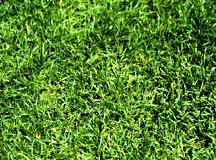 PERENNIAL RYEGRASS (Lolium perenne) – Perennial ryegrass is a smooth, shiny, short-lived perennial with slightly flattened stems. Leaves have well-developed auricles (on most leaves) and membranous ligules that may be toothed or rounded. It favors moderately moist open ground. Perennial ryegrass infested with an endophytic fungus can be the source of a neurotoxic condition (perennial ryegrass staggers) that occurs only in summer and fall. The fungus occurs in all parts of the plant, especially leaf sheaths, culms, and seeds. Affected animals exhibit fine tremors of the head and nodding movements. Well-grazed, leafy pastures that do not go to seed or are not overgrazed are less likely to be dangerous. Endophyte-free varieties should be used for pasture renovation.
PERENNIAL RYEGRASS (Lolium perenne) – Perennial ryegrass is a smooth, shiny, short-lived perennial with slightly flattened stems. Leaves have well-developed auricles (on most leaves) and membranous ligules that may be toothed or rounded. It favors moderately moist open ground. Perennial ryegrass infested with an endophytic fungus can be the source of a neurotoxic condition (perennial ryegrass staggers) that occurs only in summer and fall. The fungus occurs in all parts of the plant, especially leaf sheaths, culms, and seeds. Affected animals exhibit fine tremors of the head and nodding movements. Well-grazed, leafy pastures that do not go to seed or are not overgrazed are less likely to be dangerous. Endophyte-free varieties should be used for pasture renovation.
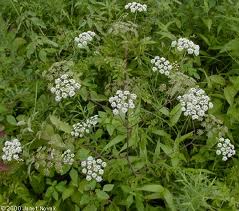 WATER HEMLOCK (Cicuta maculata) – Water hemlock is one of the most poisonous plants in Ohio. It occurs in almost all counties on the shores of lakes, ponds, marshes, bogs, and wet ditches. It is an erect perennial growing to eight-feet tall. Stems are smooth, hollow (except at nodes), and streaked with purple lines (not blotched as in the less dangerous poison hemlock, Conium maculatum). Water hemlock leaves are divided into three to seven lanceolate leaflets with irregular, coarsely toothed margins. Flowers are borne in an open umbel resembling that of wild carrot. The most distinguishing characteristic is the swollen base of the plant and rootstocks. Splitting open one of these areas reveals crosswise partitions that divide the rootstock into chambers.
WATER HEMLOCK (Cicuta maculata) – Water hemlock is one of the most poisonous plants in Ohio. It occurs in almost all counties on the shores of lakes, ponds, marshes, bogs, and wet ditches. It is an erect perennial growing to eight-feet tall. Stems are smooth, hollow (except at nodes), and streaked with purple lines (not blotched as in the less dangerous poison hemlock, Conium maculatum). Water hemlock leaves are divided into three to seven lanceolate leaflets with irregular, coarsely toothed margins. Flowers are borne in an open umbel resembling that of wild carrot. The most distinguishing characteristic is the swollen base of the plant and rootstocks. Splitting open one of these areas reveals crosswise partitions that divide the rootstock into chambers.
The yellow, oily fluid exuding (especially in springtime) from a cut stem base or rootstock contains the toxic alcohol, cicutoxin. All parts of the plant contain the toxin and are considered dangerous. Livestock have been poisoned by drinking water standing in small pools where the plant has been tramped and the roots crushed. Poisoning is most common when the plant is young, somewhat succulent, and growing rapidly. Symptoms range from nausea and colic to violent convulsions and death (especially in cattle).
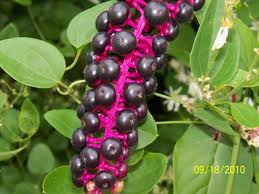 COMMON POKEWEED (Phytolacca americana) – Common pokeweed is a simple, erect, herbaceous perennial that sometimes resembles a small tree, growing up to 10 feet in height. Common pokeweed emerges each year from a large taproot or from seeds. The base of the pokeweed stem is typically deep red-purple in color. The smooth, hairless, hollow, fleshy stem can attain diameters of four inches. The large elliptical leaves range from 12- to 20-inches long. They are about a third as wide as they are long. The leaves are alternate on the stem and are hairless. Flowers are in dense, drooping clusters with white-green petals that bloom from July through August. Flower clusters occur opposite a leaf. From a distance, the purple fruit resembles a bunch of grapes that hang down from the point of attachment on the plant. Common pokeweed is found throughout Ohio in clearings and open woods and is becoming more abundant in reduced tillage fields.
COMMON POKEWEED (Phytolacca americana) – Common pokeweed is a simple, erect, herbaceous perennial that sometimes resembles a small tree, growing up to 10 feet in height. Common pokeweed emerges each year from a large taproot or from seeds. The base of the pokeweed stem is typically deep red-purple in color. The smooth, hairless, hollow, fleshy stem can attain diameters of four inches. The large elliptical leaves range from 12- to 20-inches long. They are about a third as wide as they are long. The leaves are alternate on the stem and are hairless. Flowers are in dense, drooping clusters with white-green petals that bloom from July through August. Flower clusters occur opposite a leaf. From a distance, the purple fruit resembles a bunch of grapes that hang down from the point of attachment on the plant. Common pokeweed is found throughout Ohio in clearings and open woods and is becoming more abundant in reduced tillage fields.
Pokeweed is a plant that will cause severe poisoning and is one that livestock will not avoid eating. The thick, woody roots of pokeweed are the most poisonous part of the plant and account for most livestock poisonings. The fruit of pokeweed is the least toxic part of the plant, but may be responsible for human deaths. The toxic compound is an alkaloid called phytolaccotoxin. Horses can be poisoned by eating fresh leaves or green fodder. Symptoms of poisoning from pokeweed include burning sensations in the mouth, gastrointestinal cramps, vomiting, and diarrhea.
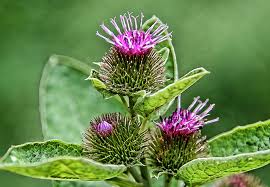 COMMON COCKLEBUR (Xanthium strumarium) – This native annual weed is troublesome in agronomic crops and is especially common on rich, moist soils. The plant is rough in appearance, branched, hairy to nearly smooth, with irregular mottled stems. The mature plant is one- to two-feet tall. The thick, rough leaves are alternate, broadly ovate to triangular, with long petioles. Flowers are relatively inconspicuous, on short axillary branches. The fruit is a bur with strong, hooked spines and two sharp-pointed beaks. The seeds are toxic but are seldom consumed because of the burs, which are too spiny to ingest. The tender, juicy cotyledons, which are long and narrow, contain carboxyatractyloside, which affects the nervous system. Signs of poisoning include anorexia, depression, and weakened heartbeat.
COMMON COCKLEBUR (Xanthium strumarium) – This native annual weed is troublesome in agronomic crops and is especially common on rich, moist soils. The plant is rough in appearance, branched, hairy to nearly smooth, with irregular mottled stems. The mature plant is one- to two-feet tall. The thick, rough leaves are alternate, broadly ovate to triangular, with long petioles. Flowers are relatively inconspicuous, on short axillary branches. The fruit is a bur with strong, hooked spines and two sharp-pointed beaks. The seeds are toxic but are seldom consumed because of the burs, which are too spiny to ingest. The tender, juicy cotyledons, which are long and narrow, contain carboxyatractyloside, which affects the nervous system. Signs of poisoning include anorexia, depression, and weakened heartbeat.
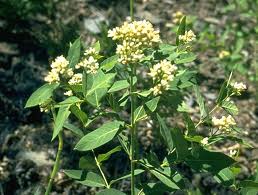 HEMP DOGBANE (Apocynum cannabinum) – Hemp dogbane, Indian hemp, choctaw root, rheumatism weed, and snake’s milk are names for this native perennial weed that is common in all counties of Ohio. Hemp dogbane is an erect plant that grows one- to four-feet tall and reproduces by creeping roots and by seeds. The leaves are two- to six-inches long, opposite, oval, and attached to the stem by a short petiole. Leaf edges and upper surface are smooth, while the underside of the leaf is finely hairy. Hemp dogbane branches freely, unlike common milkweed, with which it is often confused. All parts of the plant contain a milky latex. Shoot emergence from roots typically occurs from late-May to mid-June. The flowers of hemp dogbane are greenish-white, five-petaled, and inconspicuous. Hemp dogbane produces reddish-brown, paired sickle-shaped pods that are four- to eight-inches long and hang from the point of attachment. A related poisonous species, spreading dogbane (A. androsaemifolium), has slightly drooping leaves and larger, pink, bell-shaped flowers.
Leaves and stems of green and dry plants contain a resinoid and a glucoside with cardioactivity. Less than an ounce of green or dry leaves may be enough to kill a horse. Symptoms of poisoning include increased temperature and pulse, sweating, dilated pupils, discolored mouth and nostrils, and refusal to eat or drink. Hemp dogbane can be a threat to livestock in all seasons.
HEMP DOGBANE (Apocynum cannabinum) – Hemp dogbane, Indian hemp, choctaw root, rheumatism weed, and snake’s milk are names for this native perennial weed that is common in all counties of Ohio. Hemp dogbane is an erect plant that grows one- to four-feet tall and reproduces by creeping roots and by seeds. The leaves are two- to six-inches long, opposite, oval, and attached to the stem by a short petiole. Leaf edges and upper surface are smooth, while the underside of the leaf is finely hairy. Hemp dogbane branches freely, unlike common milkweed, with which it is often confused. All parts of the plant contain a milky latex. Shoot emergence from roots typically occurs from late-May to mid-June. The flowers of hemp dogbane are greenish-white, five-petaled, and inconspicuous. Hemp dogbane produces reddish-brown, paired sickle-shaped pods that are four- to eight-inches long and hang from the point of attachment. A related poisonous species, spreading dogbane (A. androsaemifolium), has slightly drooping leaves and larger, pink, bell-shaped flowers.
Leaves and stems of green and dry plants contain a resinoid and a glucoside with cardioactivity. Less than an ounce of green or dry leaves may be enough to kill a horse. Symptoms of poisoning include increased temperature and pulse, sweating, dilated pupils, discolored mouth and nostrils, and refusal to eat or drink. Hemp dogbane can be a threat to livestock in all seasons.
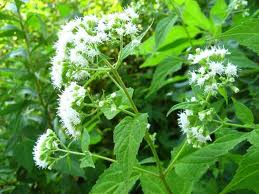 WHITE SNAKEROOT (Eupatorium rugosum) – This plant is a common perennial of shady, moist woodlands and wood edges. It often goes unnoticed because flowering does not begin until July or later. Stems are tall and mostly smooth, with opposite, long-petioled leaves. Leaf blades are generally egg-shaped, with sharply toothed margins and three prominent veins. Small white flowers are borne in loose spreading clusters.
WHITE SNAKEROOT (Eupatorium rugosum) – This plant is a common perennial of shady, moist woodlands and wood edges. It often goes unnoticed because flowering does not begin until July or later. Stems are tall and mostly smooth, with opposite, long-petioled leaves. Leaf blades are generally egg-shaped, with sharply toothed margins and three prominent veins. Small white flowers are borne in loose spreading clusters.
The toxic compound, tremetol, is found in the leaves and stems of white snakeroot and is at peak concentrations in summer through fall. Tremetol is unusual in that it is a fat-soluble molecule that becomes concentrated in the milk of lactating animals. Signs of poisoning begin with trembling in the leg muscles. Other symptoms include sweating, labored and rapid breathing, constipation, depression, stiff gait, dilated pupils, and weakness. Death may be sudden. Milk sickness, caused by drinking milk produced by animals that have eaten white snakeroot, is of historical significance because this affliction reportedly killed Abraham Lincoln’s mother.
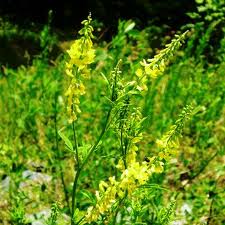 YELLOW SWEETCLOVER (Melilotus officinalis) and WHITE SWEETCLOVER (Melilotus alba) – Both species of sweetclover are widely distributed throughout the state, having been introduced in the United States long ago as a hay, pasture, and green manure crop. The sweetclovers are erect, slender, branched biennials that can grow as tall as nine feet. Leaves are clover-like, with three oblong leaflets that are toothed around the entire margin. Flowers are small, white or yellow, and fragrant; they appear in long, slender clusters at branch tips or arising from leaf axils. Fruits are ovoid, smooth pods with one to four seeds. The plant is commonly found along roadsides, railroad tracks, open fields, and waste areas.
YELLOW SWEETCLOVER (Melilotus officinalis) and WHITE SWEETCLOVER (Melilotus alba) – Both species of sweetclover are widely distributed throughout the state, having been introduced in the United States long ago as a hay, pasture, and green manure crop. The sweetclovers are erect, slender, branched biennials that can grow as tall as nine feet. Leaves are clover-like, with three oblong leaflets that are toothed around the entire margin. Flowers are small, white or yellow, and fragrant; they appear in long, slender clusters at branch tips or arising from leaf axils. Fruits are ovoid, smooth pods with one to four seeds. The plant is commonly found along roadsides, railroad tracks, open fields, and waste areas.
As a forage crop, sweetclovers can be freely grazed, but feeding moldy sweetclover hay or silage is dangerous. Thus, sweetclover poisoning usually occurs in winter and is not apparent until animals have been fed damaged sweetclover hay for two or more weeks. Well-cured hay is not dangerous, but absence of visible spoilage does not necessarily mean the hay is safe to feed.
Poisoning results from the process of spoiling, or molding, wherein harmless natural coumarins are converted to toxic dicumarol. The most dangerous hay is the outer portion of weathered, large round bales. The main sign of poisoning is hemorrhaging, which results from faulty blood coagulation. The toxic compound crosses the placenta and may affect newborns.
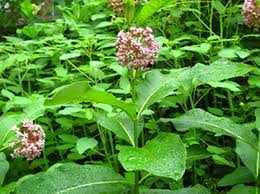 COMMON MILKWEED (Asclepias syriaca) – Common milkweed is an erect perennial that reproduces by creeping roots and seeds. Stems, reaching three to six feet in height, are unbranched and covered with short downy hairs. The leaves are oblong, three- to eight-inches long, with a rounded to tapered leaf tip and base. Leaves are opposite and are attached directly to the stem. The underside of the leaves are covered with fine velvet-like hairs. The upper surface, which can be hairless or hairy, shows a prominent white midrib. The secondary veins off the midrib resemble the rungs of a ladder. Young seedlings and emerging vegetative shoots of common milkweed are covered with downy hairs, thus differentiating them from hemp dogbane. The milkweed family is known for a white milky sap that appears when the plant is bruised or cut open. Flowers are borne in a large ball-like cluster and are sweet-smelling, pink-lavender in color, and bloom from June to August. The gray, rough, spiny pods are three- to five-inches long, one-inch wide, and split on one side. The seeds inside of the pod are brown, flat, and oval. They resemble an enclosed horseshoe with an attached downy pappus (silky structure similar to that of dandelion). Common milkweed is native to North America and is found throughout Ohio. It grows best in warm, dry soils with full sunlight and is commonly found growing in clumps or patches on roadsides and in reduced tillage fields.
COMMON MILKWEED (Asclepias syriaca) – Common milkweed is an erect perennial that reproduces by creeping roots and seeds. Stems, reaching three to six feet in height, are unbranched and covered with short downy hairs. The leaves are oblong, three- to eight-inches long, with a rounded to tapered leaf tip and base. Leaves are opposite and are attached directly to the stem. The underside of the leaves are covered with fine velvet-like hairs. The upper surface, which can be hairless or hairy, shows a prominent white midrib. The secondary veins off the midrib resemble the rungs of a ladder. Young seedlings and emerging vegetative shoots of common milkweed are covered with downy hairs, thus differentiating them from hemp dogbane. The milkweed family is known for a white milky sap that appears when the plant is bruised or cut open. Flowers are borne in a large ball-like cluster and are sweet-smelling, pink-lavender in color, and bloom from June to August. The gray, rough, spiny pods are three- to five-inches long, one-inch wide, and split on one side. The seeds inside of the pod are brown, flat, and oval. They resemble an enclosed horseshoe with an attached downy pappus (silky structure similar to that of dandelion). Common milkweed is native to North America and is found throughout Ohio. It grows best in warm, dry soils with full sunlight and is commonly found growing in clumps or patches on roadsides and in reduced tillage fields.
All parts of the plant, whether green or dry, are poisonous to horses. The toxic principles are steroid glycosides and toxic resinous substances. Livestock generally avoid this plant unless other forage is unavailable. Signs of poisoning include dizziness, loss of muscular control, violent spasms, rapid and weak pulse, respiratory paralysis, and rarely death.
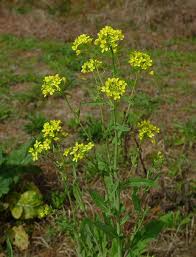 MUSTARDS (Brassica) spp., (Raphanus) spp., and related genera – The mustard family (Cruciferae) comprises a large group of herbaceous plants, most of which are annuals, winter annuals, or biennials. Flowers, with four sepals, four petals, and six stamens (two short and four long) are yellow or white, and arranged in racemes. Fruits are borne in two-chambered, flat-round, or beaked tubular capsules. Basal leaves are generally lobed or coarsely toothed. Mustards are found throughout Ohio along roadsides, waste areas, open fields, and pastures. Seeds of many species live a long time in the soil, and seedlings reappear after many years when soil is disturbed.
MUSTARDS (Brassica) spp., (Raphanus) spp., and related genera – The mustard family (Cruciferae) comprises a large group of herbaceous plants, most of which are annuals, winter annuals, or biennials. Flowers, with four sepals, four petals, and six stamens (two short and four long) are yellow or white, and arranged in racemes. Fruits are borne in two-chambered, flat-round, or beaked tubular capsules. Basal leaves are generally lobed or coarsely toothed. Mustards are found throughout Ohio along roadsides, waste areas, open fields, and pastures. Seeds of many species live a long time in the soil, and seedlings reappear after many years when soil is disturbed.
Many mustards are harmless when young and are grazed without incident. However, seeds and vegetative parts (fresh and dry) may contain the toxic principle glucosinolate (isothiocyanate). Feeds containing grain screenings with a large number of mustard seeds may be dangerous to horses. Mustard oils, which are released by enzymes when mustard seeds are moistened with cold water before feeding, are strong irritants. Signs of poisoning include acute/chronic anorexia, severe gastroenteritis, salivation, diarrhea, paralysis, photosensitization, and hemoglobinuria.
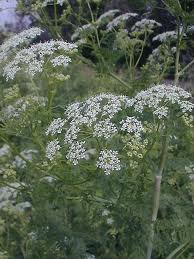 POISON HEMLOCK (Conium maculatum) – Poison hemlock is a tall, erect biennial that produces a vegetative rosette the first season of growth and an upright reproductive stem in the second season. Stems are mostly hairless and light gray-green with distinct reddish-purple spots. They are hollow, except at the nodes, and grow to 10-feet tall. Leaves are basal in the rosette stage and alternate on the stem in the reproductive stage. The basal and stem leaves are finely dissected with a lace-like appearance, resembling the nonpoisonous wild carrot. The flower heads at the top of the plant are large, one to three inches in diameter, white, and umbrella-shaped. Flowers develop into a green, deeply ridged fruit with several seeds. The plant has an unmistakable and disagreeable mouse-like odor.
POISON HEMLOCK (Conium maculatum) – Poison hemlock is a tall, erect biennial that produces a vegetative rosette the first season of growth and an upright reproductive stem in the second season. Stems are mostly hairless and light gray-green with distinct reddish-purple spots. They are hollow, except at the nodes, and grow to 10-feet tall. Leaves are basal in the rosette stage and alternate on the stem in the reproductive stage. The basal and stem leaves are finely dissected with a lace-like appearance, resembling the nonpoisonous wild carrot. The flower heads at the top of the plant are large, one to three inches in diameter, white, and umbrella-shaped. Flowers develop into a green, deeply ridged fruit with several seeds. The plant has an unmistakable and disagreeable mouse-like odor.
Poison hemlock was introduced from Eurasia as an ornamental plant and is currently found in about half of the counties in Ohio. It grows in waste areas, especially partially shaded, poorly drained sites, stream banks, or edges of cultivated fields. Seeds germinate in autumn, and seedlings grow late into fall. It is one of few green plants in pastures in late winter and is among the first plants to green up in the early spring. This plant is sometimes confused with wild carrot or wild parsnip.
All parts of this plant are poisonous, though roots are more toxic than leaves or stems. Leaves are especially poisonous in the spring, whereas the root becomes more toxic over time. Eight alkaloids are found in this plant, with coniine and conicine being the most common. Livestock can be severely injured by eating the leaves or fruits of poison hemlock. The strong odor usually prevents consumption of the green plant, but animals can be poisoned by eating contaminated fresh hay or silage. Signs of poisoning include dilated pupils, weakness, staggering gait, and respiratory paralysis two to three hours after ingestion.
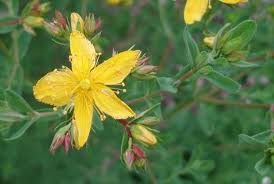 COMMON ST. JOHNSWORT (Hypericum perforatum) – Common St. Johnswort is a creeping perennial that reproduces by seeds and spreading underground roots. This species has hairless, branched reddish stems with a woody base and grows up to three-feet tall. St. Johnswort is characterized by its small (one-half to one-and-one-half inches long) oval, opposite leaves and large stomata that appear as small perforations or holes in the leaves when held up to the light. The leaves are attached directly to the stem. Distinct bright yellow flowers (three-quarters to one inch in diameter) with many stamens are numerous and may have black dots on the edges of the petals. The fruit is a three-celled capsule with many dark brown seeds. When wet, the seeds have a gelatinous coating that sticks them to objects (e.g., animal legs, hooves, machinery).
COMMON ST. JOHNSWORT (Hypericum perforatum) – Common St. Johnswort is a creeping perennial that reproduces by seeds and spreading underground roots. This species has hairless, branched reddish stems with a woody base and grows up to three-feet tall. St. Johnswort is characterized by its small (one-half to one-and-one-half inches long) oval, opposite leaves and large stomata that appear as small perforations or holes in the leaves when held up to the light. The leaves are attached directly to the stem. Distinct bright yellow flowers (three-quarters to one inch in diameter) with many stamens are numerous and may have black dots on the edges of the petals. The fruit is a three-celled capsule with many dark brown seeds. When wet, the seeds have a gelatinous coating that sticks them to objects (e.g., animal legs, hooves, machinery).
Common St. Johnswort, also called klamathweed or goatweed, is an introduced species native to Eurasia. It is common in the eastern part of Ohio, but is sporadically distributed in western Ohio. This species is commonly found in old meadows, pastures, roadsides, waste areas, and in reduced tillage agronomic systems. In total, there are 16 different species of Hypericum in Ohio. The name Hypericum is from a Greek word meaning "over an apparition," alluding to its ancient use as an herb to protect one from evil spirits. The species name, perforatum, refers to the perforated look of the leaves.
Leaves and flowers of common St. Johnswort contain a photodynamic pigment called hypericin, which causes "photosensitization" on white or light-colored skin. Photosensitization is especially prevalent on areas of the body which receive the most sunlight, such as the head, neck, and back. Affected skin becomes swollen, tender, and reddened (erythema), and large areas may peel off. Other signs of poisoning include loss of appetite, severe itching, blindness, convulsions, hypersensitivity to cold water, and coma. The plant is dangerous at all growth stages. Grazing animals may also suffer minor skin irritations that include skin blisters and hair loss. If enough of this plant is ingested, death may result. The toxic properties of St. Johnswort remain when it is a contaminant of hay.
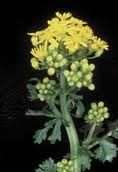 GROUNDSELS (Senecio) spp. – There are eight species of Senecio recognized in Ohio, the most poisonous being the relatively uncommon cressleaf groundsel (S. glabellus), also called butterweed or yellowtop. Cressleaf groundsel is an erect biennial reaching heights of one to three feet. The stem is succulent, smooth, and hollow, and it branches at the top to support flowers. Leaves are alternate, deeply divided, with wide, round-toothed lobes. Basal and lower leaves are up to eight-inches long; upper leaves are smaller but similar in shape. Bright lemon-yellow flowers, up to one inch in diameter, are borne in clusters and bloom from April to June. Cressleaf groundsel occurs in wet woods, swamps, streambanks, wet ditches, and pastures. The weed is uncommon, but is known to spread quickly. The related weedy species, common groundsel (S. vulgaris), is more common, and is distinguished by the absence of ray flowers and a solid, shorter stem. Common groundsel is found in fields and waste places.
GROUNDSELS (Senecio) spp. – There are eight species of Senecio recognized in Ohio, the most poisonous being the relatively uncommon cressleaf groundsel (S. glabellus), also called butterweed or yellowtop. Cressleaf groundsel is an erect biennial reaching heights of one to three feet. The stem is succulent, smooth, and hollow, and it branches at the top to support flowers. Leaves are alternate, deeply divided, with wide, round-toothed lobes. Basal and lower leaves are up to eight-inches long; upper leaves are smaller but similar in shape. Bright lemon-yellow flowers, up to one inch in diameter, are borne in clusters and bloom from April to June. Cressleaf groundsel occurs in wet woods, swamps, streambanks, wet ditches, and pastures. The weed is uncommon, but is known to spread quickly. The related weedy species, common groundsel (S. vulgaris), is more common, and is distinguished by the absence of ray flowers and a solid, shorter stem. Common groundsel is found in fields and waste places.
Groundsel species contain pyrrolizidine alkaloids (e.g., senecionine), which cause irreversible liver damage with prolonged exposure. All parts of common groundsel contain toxins; however, toxin concentrations are greatest in the flowers, and in the leaves just before flowers reach maturity. Obvious signs of poisoning often do not appear until liver damage is severe. Early symptoms include anorexia and depression and are followed by incoordination, diarrhea, presence of hemoglobin in the urine, cirrhosis of the liver, and death.
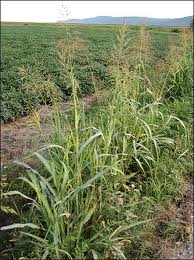 JOHNSONGRASS (Sorghum halepense) – Johnsongrass is a tall (up to 10 feet) coarse-textured perennial grass that reproduces by rhizomes and seeds. Leaves are rolled in the bud and have a tall membranous ligule with shallow teeth on the top. Leaf blades are long (eight to 24 inches), smooth, and flat, with a thick, prominent white midvein. Leaves are usually bright green, but they may also contain purple pigmented spots. In the vegetative stage, Johnsongrass looks like a narrow-leaved corn plant. The seedhead is large, purple, and pyramidal in shape, with dark reddish-brown, oval seeds.
JOHNSONGRASS (Sorghum halepense) – Johnsongrass is a tall (up to 10 feet) coarse-textured perennial grass that reproduces by rhizomes and seeds. Leaves are rolled in the bud and have a tall membranous ligule with shallow teeth on the top. Leaf blades are long (eight to 24 inches), smooth, and flat, with a thick, prominent white midvein. Leaves are usually bright green, but they may also contain purple pigmented spots. In the vegetative stage, Johnsongrass looks like a narrow-leaved corn plant. The seedhead is large, purple, and pyramidal in shape, with dark reddish-brown, oval seeds.
Johnsongrass was brought to United States from the Mediterranean as a contaminant of crop seeds. It is named for Colonel William Johnson who introduced this species on his farm in Alabama around 1840. Johnsongrass is often found in many Ohio counties, especially along irrigated canals, fields, and other areas with rich soils. This species is considered among the world’s 10 worst weeds. Hydrocyanic acid (cyanide) is produced in the leaves and stems of Johnsongrass when it is subjected to drought, trampling, frost, herbicide treatment, and even cutting. Toxicity is identical to that of Prunus poisoning and results in hypoxia (deficiency of oxygen reaching the tissues). The first symptoms appear within a few minutes following ingestion. Affected animals exhibit excitement, incoordination, convulsions, rapid and labored breathing, bloating, and coma. Death can occur in less than an hour due to internal asphyxiation.
Toxic levels of nitrates can accumulate in Johnsongrass following heavy fertilization or drought and result in toxicosis which may be confused with cyanide poisoning. Common symptoms of nitrate poisoning include stomach and intestinal irritation and may result in hypoxia (deficiency of oxygen reaching the tissues). Horses are less susceptible to cyanide and nitrate poisoning than are ruminants.
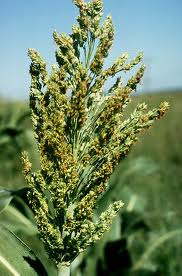 SORGHUMS (Sorghum vulgare, Sorghum vulgare sudanense) and hybrids – Sorghums are tall (up to eight feet), coarse, annual grasses with large terminal panicles. There are numerous varieties, some of which are cultivated for forage, syrup, broom, or grain production. Under unfavorable conditions, all may be poisonous. As with Johnsongrass, hydrocyanic acid is produced in sorghum in response to drought, trampling, frost, or second growth, and nitrates accumulate with heavy fertilization or drought. Affected animals exhibit signs of hypoxia, including difficulty breathing, bloat, staggering, convulsions, and death. Sorghum poisoning is especially a problem in horses following grazing of sorghum pastures for several weeks to months.
SORGHUMS (Sorghum vulgare, Sorghum vulgare sudanense) and hybrids – Sorghums are tall (up to eight feet), coarse, annual grasses with large terminal panicles. There are numerous varieties, some of which are cultivated for forage, syrup, broom, or grain production. Under unfavorable conditions, all may be poisonous. As with Johnsongrass, hydrocyanic acid is produced in sorghum in response to drought, trampling, frost, or second growth, and nitrates accumulate with heavy fertilization or drought. Affected animals exhibit signs of hypoxia, including difficulty breathing, bloat, staggering, convulsions, and death. Sorghum poisoning is especially a problem in horses following grazing of sorghum pastures for several weeks to months.
NIGHTSHADE FAMILY
The Solanaceae, or nightshade family, contains several important poisonous plants. The toxic principle is the same for all. The glycoalkaloid, solanine, is produced in leaves, shoots, and unripe berries, and causes gastrointestinal irritation and central nervous system problems. Symptoms of poisoning include acute hemorrhagic gastroenteritis, weakness, incoordination, difficulty breathing, excess salivation, and death.
The most important species in Ohio are eastern black nightshade, bittersweet nightshade, horsenettle, and two species of groundcherry. The common potato can also be dangerous, in that white sprouts and green parts of the plant, especially green skinned tubers, are poisonous. Identifying features of the weedy species are given here.
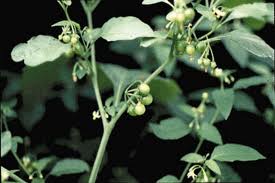 EASTERN BLACK NIGHTSHADE (Solanum nigrum) is an erect annual. Leaves are coarsely and shallowly toothed, with slight pubescence on the undersurface. Flowers are white to purple and are borne in an open cluster. The juicy, many-seeded berries are initially green, ripening to purplish black. Eastern black nightshade is widespread in Ohio and is found along stream banks, thickets, roadsides, row crop fields, and other open, disturbed habitats.
EASTERN BLACK NIGHTSHADE (Solanum nigrum) is an erect annual. Leaves are coarsely and shallowly toothed, with slight pubescence on the undersurface. Flowers are white to purple and are borne in an open cluster. The juicy, many-seeded berries are initially green, ripening to purplish black. Eastern black nightshade is widespread in Ohio and is found along stream banks, thickets, roadsides, row crop fields, and other open, disturbed habitats.
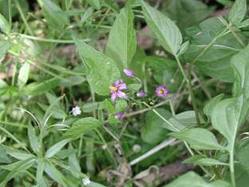 BITTERSWEET NIGHTSHADE (Solanum dulcamara) is also known as European bittersweet, poison berry, climbing nightshade, and deadly nightshade. It was introduced from Eurasia as an ornamental and is now distributed throughout Ohio. It is found in hedgerows, ditches, waste areas, and open fields, especially areas that tend to be moist or even waterlogged for a portion of the year. Bittersweet nightshade is a creeping perennial vine that spreads by rhizomes and reproduces by seed. Leaves are arranged alternate on a dark red to black woody stem. The leaves are of two forms – one is simple and ovate and the other is similar with additional basal lobes. Both forms are two to four-and-one-half inches in length, have smooth leaf margins, and are a dark green color with a purple tinge. Leaves may be either with or without hair. Flower clusters branch from the main stem. Flowers are one-half inches in diameter, with five purple petals that join together to form a star-shape with a yellow center. Fruits are oval green (immature) to red (mature) berries and are thin-skinned with many flat, yellow round seeds. Leaves, stems, and berries can be poisonous.
BITTERSWEET NIGHTSHADE (Solanum dulcamara) is also known as European bittersweet, poison berry, climbing nightshade, and deadly nightshade. It was introduced from Eurasia as an ornamental and is now distributed throughout Ohio. It is found in hedgerows, ditches, waste areas, and open fields, especially areas that tend to be moist or even waterlogged for a portion of the year. Bittersweet nightshade is a creeping perennial vine that spreads by rhizomes and reproduces by seed. Leaves are arranged alternate on a dark red to black woody stem. The leaves are of two forms – one is simple and ovate and the other is similar with additional basal lobes. Both forms are two to four-and-one-half inches in length, have smooth leaf margins, and are a dark green color with a purple tinge. Leaves may be either with or without hair. Flower clusters branch from the main stem. Flowers are one-half inches in diameter, with five purple petals that join together to form a star-shape with a yellow center. Fruits are oval green (immature) to red (mature) berries and are thin-skinned with many flat, yellow round seeds. Leaves, stems, and berries can be poisonous.
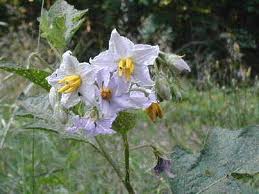 HORSENETTLE (Solanum carolinense) is sometimes called bull nettle, devil’s potato, or wild tomato. It is an erect creeping perennial weed that spreads by rhizomes and reproduces by seeds. Horsenettle is characterized by hard sharp yellowish spines found on the stems and leaves. Leaves are alternate, finely hairy on both surfaces, egg-shaped (one-and-one-half to five-and-one-half inches long and three-quarters to two-and-one-half inches wide), with very coarsely toothed margins, resembling a poinsettia leaf. Flowers are star-shaped with five white to violet petals with bright yellow anthers. Fruits are green when young and turn to yellow-orange and wrinkle as they mature. Berries contain many round, flat, yellow to orange seeds. Horsenettle is native to the southeastern United States but is distributed throughout all Ohio counties. It is commonly found in pastures because most animals will avoid eating it; it is also found in waste areas and open fields. All parts of the plant are poisonous, with the level of solanine highest in the fall.
HORSENETTLE (Solanum carolinense) is sometimes called bull nettle, devil’s potato, or wild tomato. It is an erect creeping perennial weed that spreads by rhizomes and reproduces by seeds. Horsenettle is characterized by hard sharp yellowish spines found on the stems and leaves. Leaves are alternate, finely hairy on both surfaces, egg-shaped (one-and-one-half to five-and-one-half inches long and three-quarters to two-and-one-half inches wide), with very coarsely toothed margins, resembling a poinsettia leaf. Flowers are star-shaped with five white to violet petals with bright yellow anthers. Fruits are green when young and turn to yellow-orange and wrinkle as they mature. Berries contain many round, flat, yellow to orange seeds. Horsenettle is native to the southeastern United States but is distributed throughout all Ohio counties. It is commonly found in pastures because most animals will avoid eating it; it is also found in waste areas and open fields. All parts of the plant are poisonous, with the level of solanine highest in the fall.
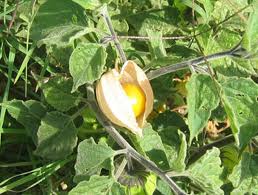 GROUNDCHERRIES include seven species of the genus Physalis which have been found in Ohio, the most common being smooth groundcherry (P. longifolia var. subglabrata) and clammy groundcherry (P. heterophylla). The main difference between the two species is that the former is smooth and the latter is densely hairy. Both species are found in almost all counties of Ohio and are sometimes called hog-plum, husk-tomato, or wild-pompion. They are commonly found in cultivated and reduced tillage agronomic fields, as well as in pastures, along roadsides, and in waste areas. Both groundcherry species are erect perennials growing one to three-feet in height. They reproduce by seed and vegetatively by creeping roots. Stems are ridged and hollow, with spreading branches. Leaves (two- to four-inches long and three-quarters to one-and-one-half-inches wide) are alternate, unevenly toothed, and approximately diamond-shaped, tapering towards the petioles. Flowers are bell-shaped with a yellow corolla (one-half inches in diameter) that may have a violet-spotted center. A five-sided lanternlike pod hangs from the plant and encloses a berry or groundcherry. The fruit is a green to purple fleshy berry approximately one-half inch in diameter, with many kidney-shaped seeds. Leaves and unripe fruit are poisonous.
GROUNDCHERRIES include seven species of the genus Physalis which have been found in Ohio, the most common being smooth groundcherry (P. longifolia var. subglabrata) and clammy groundcherry (P. heterophylla). The main difference between the two species is that the former is smooth and the latter is densely hairy. Both species are found in almost all counties of Ohio and are sometimes called hog-plum, husk-tomato, or wild-pompion. They are commonly found in cultivated and reduced tillage agronomic fields, as well as in pastures, along roadsides, and in waste areas. Both groundcherry species are erect perennials growing one to three-feet in height. They reproduce by seed and vegetatively by creeping roots. Stems are ridged and hollow, with spreading branches. Leaves (two- to four-inches long and three-quarters to one-and-one-half-inches wide) are alternate, unevenly toothed, and approximately diamond-shaped, tapering towards the petioles. Flowers are bell-shaped with a yellow corolla (one-half inches in diameter) that may have a violet-spotted center. A five-sided lanternlike pod hangs from the plant and encloses a berry or groundcherry. The fruit is a green to purple fleshy berry approximately one-half inch in diameter, with many kidney-shaped seeds. Leaves and unripe fruit are poisonous.
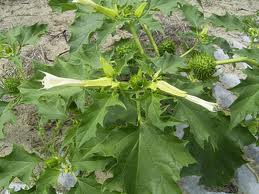
JIMSONWEED (Datura stramonium) is a foul-smelling coarse annual. Stems are erect, up to four feet tall, smooth to slightly pubescent, and green to purple. The leaf shape resembles that of poinsettia, with irregular, coarsely toothed to shallowly lobed margins. Flowers are borne singly on short stalks in the axils of branches. The flower is a white to purple five-angled tube with a spreading, toothed, plaited border. The funnel-shaped flower is two- to five-inches long and one to two inches across. The fruit is a distinctive, hard, prickly, many-seeded capsule splitting into four sections.
The plant is native to the tropics but is naturalized throughout Ohio. It is common around barnyards, feedlots (especially hog lots), cultivated fields, roadsides, and other disturbed habitats. Other names for this weed are thorn-apple and jamestown-weed. All parts of the plant, and seeds in particular, contain tropane alkaloids (atropine, scopolamine, hyoscyamine). Because of the strong odor and taste, animals seldom consume enough of the green plant to be affected, but poisonings result from eating the dry plant in hay or silage, or from seeds mixed with grain. Affected animals may exhibit a weak, rapid pulse, dilated pupils, dry mouth, incoordination, diarrhea, convulsions, coma, and sometimes death.
Credit - Ohio State University Extension.
Return to Horse Riding Connection

 FIELD HORSETAIL (Equisetum arvense) – Field horsetail is the most common of several horsetails and it is also the most variable. This is a unique plant with two distinct growth forms (sterile and fertile stems), which often are not found together. The sterile stems are light green, highly branched, resembling a small pine tree. Stems are ascending and appear to be leafless; they may be perennial and evergreen, or annual, dying in autumn after frost. The stem has distinct joints or nodes, which bear tiny, black, scalelike leaves. The fertile stems are singular, tall, dark green, ridged, hollow, tubular, and distinctly jointed. Branches, when present, arise singly or in whorls at nodes. The stem terminates in a cone-shaped spore-bearing strobilus. The stem is rough like sandpaper due to impregnation with silica. The plant reproduces by spores or by deep, creeping rootstocks which sometimes bear tubers.
FIELD HORSETAIL (Equisetum arvense) – Field horsetail is the most common of several horsetails and it is also the most variable. This is a unique plant with two distinct growth forms (sterile and fertile stems), which often are not found together. The sterile stems are light green, highly branched, resembling a small pine tree. Stems are ascending and appear to be leafless; they may be perennial and evergreen, or annual, dying in autumn after frost. The stem has distinct joints or nodes, which bear tiny, black, scalelike leaves. The fertile stems are singular, tall, dark green, ridged, hollow, tubular, and distinctly jointed. Branches, when present, arise singly or in whorls at nodes. The stem terminates in a cone-shaped spore-bearing strobilus. The stem is rough like sandpaper due to impregnation with silica. The plant reproduces by spores or by deep, creeping rootstocks which sometimes bear tubers.
 TALL FESCUE (Festuca arundinacea) – Tall fescue is probably the most widely adapted perennial pasture grass. It is a tall (up to five feet), tufted, deep-rooted plant that forms a coarse sod. Leaves are about one-quarter inch wide, with a ridged surface and fine, sharp, saw-toothed edges. The inflorescence is a compact panicle four- to 10-inches long. Although fescue poisoning is a condition of cattle, summer fescue toxicosis can affect horses during summer when grazing or fed tall fescue forage or seed. Toxin is produced in tall fescue forage or seeds contaminated with an endophytic fungus. Affected animals show reduced feed intake and weight gains. Within one or two weeks after fescue feeding has begun, other signs such as fever may appear. Failure to produce or let down milk can be a problem in mares grazing endophyte-infected fescue. The severity of the toxin may vary from field to field, but increases when temperatures exceed 75 to 80ºF, and where high rates of nitrogen fertilizer have been applied to the grass. Tall fescue varieties are available that do not contain the endophyte; toxic pastures should be destroyed and planted to nonendophytic fescue varieties.
TALL FESCUE (Festuca arundinacea) – Tall fescue is probably the most widely adapted perennial pasture grass. It is a tall (up to five feet), tufted, deep-rooted plant that forms a coarse sod. Leaves are about one-quarter inch wide, with a ridged surface and fine, sharp, saw-toothed edges. The inflorescence is a compact panicle four- to 10-inches long. Although fescue poisoning is a condition of cattle, summer fescue toxicosis can affect horses during summer when grazing or fed tall fescue forage or seed. Toxin is produced in tall fescue forage or seeds contaminated with an endophytic fungus. Affected animals show reduced feed intake and weight gains. Within one or two weeks after fescue feeding has begun, other signs such as fever may appear. Failure to produce or let down milk can be a problem in mares grazing endophyte-infected fescue. The severity of the toxin may vary from field to field, but increases when temperatures exceed 75 to 80ºF, and where high rates of nitrogen fertilizer have been applied to the grass. Tall fescue varieties are available that do not contain the endophyte; toxic pastures should be destroyed and planted to nonendophytic fescue varieties.
 PERENNIAL RYEGRASS (Lolium perenne) – Perennial ryegrass is a smooth, shiny, short-lived perennial with slightly flattened stems. Leaves have well-developed auricles (on most leaves) and membranous ligules that may be toothed or rounded. It favors moderately moist open ground. Perennial ryegrass infested with an endophytic fungus can be the source of a neurotoxic condition (perennial ryegrass staggers) that occurs only in summer and fall. The fungus occurs in all parts of the plant, especially leaf sheaths, culms, and seeds. Affected animals exhibit fine tremors of the head and nodding movements. Well-grazed, leafy pastures that do not go to seed or are not overgrazed are less likely to be dangerous. Endophyte-free varieties should be used for pasture renovation.
PERENNIAL RYEGRASS (Lolium perenne) – Perennial ryegrass is a smooth, shiny, short-lived perennial with slightly flattened stems. Leaves have well-developed auricles (on most leaves) and membranous ligules that may be toothed or rounded. It favors moderately moist open ground. Perennial ryegrass infested with an endophytic fungus can be the source of a neurotoxic condition (perennial ryegrass staggers) that occurs only in summer and fall. The fungus occurs in all parts of the plant, especially leaf sheaths, culms, and seeds. Affected animals exhibit fine tremors of the head and nodding movements. Well-grazed, leafy pastures that do not go to seed or are not overgrazed are less likely to be dangerous. Endophyte-free varieties should be used for pasture renovation.
 WATER HEMLOCK (Cicuta maculata) – Water hemlock is one of the most poisonous plants in Ohio. It occurs in almost all counties on the shores of lakes, ponds, marshes, bogs, and wet ditches. It is an erect perennial growing to eight-feet tall. Stems are smooth, hollow (except at nodes), and streaked with purple lines (not blotched as in the less dangerous poison hemlock, Conium maculatum). Water hemlock leaves are divided into three to seven lanceolate leaflets with irregular, coarsely toothed margins. Flowers are borne in an open umbel resembling that of wild carrot. The most distinguishing characteristic is the swollen base of the plant and rootstocks. Splitting open one of these areas reveals crosswise partitions that divide the rootstock into chambers.
WATER HEMLOCK (Cicuta maculata) – Water hemlock is one of the most poisonous plants in Ohio. It occurs in almost all counties on the shores of lakes, ponds, marshes, bogs, and wet ditches. It is an erect perennial growing to eight-feet tall. Stems are smooth, hollow (except at nodes), and streaked with purple lines (not blotched as in the less dangerous poison hemlock, Conium maculatum). Water hemlock leaves are divided into three to seven lanceolate leaflets with irregular, coarsely toothed margins. Flowers are borne in an open umbel resembling that of wild carrot. The most distinguishing characteristic is the swollen base of the plant and rootstocks. Splitting open one of these areas reveals crosswise partitions that divide the rootstock into chambers.  COMMON POKEWEED (Phytolacca americana) – Common pokeweed is a simple, erect, herbaceous perennial that sometimes resembles a small tree, growing up to 10 feet in height. Common pokeweed emerges each year from a large taproot or from seeds. The base of the pokeweed stem is typically deep red-purple in color. The smooth, hairless, hollow, fleshy stem can attain diameters of four inches. The large elliptical leaves range from 12- to 20-inches long. They are about a third as wide as they are long. The leaves are alternate on the stem and are hairless. Flowers are in dense, drooping clusters with white-green petals that bloom from July through August. Flower clusters occur opposite a leaf. From a distance, the purple fruit resembles a bunch of grapes that hang down from the point of attachment on the plant. Common pokeweed is found throughout Ohio in clearings and open woods and is becoming more abundant in reduced tillage fields.
COMMON POKEWEED (Phytolacca americana) – Common pokeweed is a simple, erect, herbaceous perennial that sometimes resembles a small tree, growing up to 10 feet in height. Common pokeweed emerges each year from a large taproot or from seeds. The base of the pokeweed stem is typically deep red-purple in color. The smooth, hairless, hollow, fleshy stem can attain diameters of four inches. The large elliptical leaves range from 12- to 20-inches long. They are about a third as wide as they are long. The leaves are alternate on the stem and are hairless. Flowers are in dense, drooping clusters with white-green petals that bloom from July through August. Flower clusters occur opposite a leaf. From a distance, the purple fruit resembles a bunch of grapes that hang down from the point of attachment on the plant. Common pokeweed is found throughout Ohio in clearings and open woods and is becoming more abundant in reduced tillage fields.  COMMON COCKLEBUR (Xanthium strumarium) – This native annual weed is troublesome in agronomic crops and is especially common on rich, moist soils. The plant is rough in appearance, branched, hairy to nearly smooth, with irregular mottled stems. The mature plant is one- to two-feet tall. The thick, rough leaves are alternate, broadly ovate to triangular, with long petioles. Flowers are relatively inconspicuous, on short axillary branches. The fruit is a bur with strong, hooked spines and two sharp-pointed beaks. The seeds are toxic but are seldom consumed because of the burs, which are too spiny to ingest. The tender, juicy cotyledons, which are long and narrow, contain carboxyatractyloside, which affects the nervous system. Signs of poisoning include anorexia, depression, and weakened heartbeat.
COMMON COCKLEBUR (Xanthium strumarium) – This native annual weed is troublesome in agronomic crops and is especially common on rich, moist soils. The plant is rough in appearance, branched, hairy to nearly smooth, with irregular mottled stems. The mature plant is one- to two-feet tall. The thick, rough leaves are alternate, broadly ovate to triangular, with long petioles. Flowers are relatively inconspicuous, on short axillary branches. The fruit is a bur with strong, hooked spines and two sharp-pointed beaks. The seeds are toxic but are seldom consumed because of the burs, which are too spiny to ingest. The tender, juicy cotyledons, which are long and narrow, contain carboxyatractyloside, which affects the nervous system. Signs of poisoning include anorexia, depression, and weakened heartbeat.
 HEMP DOGBANE (Apocynum cannabinum) – Hemp dogbane, Indian hemp, choctaw root, rheumatism weed, and snake’s milk are names for this native perennial weed that is common in all counties of Ohio. Hemp dogbane is an erect plant that grows one- to four-feet tall and reproduces by creeping roots and by seeds. The leaves are two- to six-inches long, opposite, oval, and attached to the stem by a short petiole. Leaf edges and upper surface are smooth, while the underside of the leaf is finely hairy. Hemp dogbane branches freely, unlike common milkweed, with which it is often confused. All parts of the plant contain a milky latex. Shoot emergence from roots typically occurs from late-May to mid-June. The flowers of hemp dogbane are greenish-white, five-petaled, and inconspicuous. Hemp dogbane produces reddish-brown, paired sickle-shaped pods that are four- to eight-inches long and hang from the point of attachment. A related poisonous species, spreading dogbane (A. androsaemifolium), has slightly drooping leaves and larger, pink, bell-shaped flowers.
Leaves and stems of green and dry plants contain a resinoid and a glucoside with cardioactivity. Less than an ounce of green or dry leaves may be enough to kill a horse. Symptoms of poisoning include increased temperature and pulse, sweating, dilated pupils, discolored mouth and nostrils, and refusal to eat or drink. Hemp dogbane can be a threat to livestock in all seasons.
HEMP DOGBANE (Apocynum cannabinum) – Hemp dogbane, Indian hemp, choctaw root, rheumatism weed, and snake’s milk are names for this native perennial weed that is common in all counties of Ohio. Hemp dogbane is an erect plant that grows one- to four-feet tall and reproduces by creeping roots and by seeds. The leaves are two- to six-inches long, opposite, oval, and attached to the stem by a short petiole. Leaf edges and upper surface are smooth, while the underside of the leaf is finely hairy. Hemp dogbane branches freely, unlike common milkweed, with which it is often confused. All parts of the plant contain a milky latex. Shoot emergence from roots typically occurs from late-May to mid-June. The flowers of hemp dogbane are greenish-white, five-petaled, and inconspicuous. Hemp dogbane produces reddish-brown, paired sickle-shaped pods that are four- to eight-inches long and hang from the point of attachment. A related poisonous species, spreading dogbane (A. androsaemifolium), has slightly drooping leaves and larger, pink, bell-shaped flowers.
Leaves and stems of green and dry plants contain a resinoid and a glucoside with cardioactivity. Less than an ounce of green or dry leaves may be enough to kill a horse. Symptoms of poisoning include increased temperature and pulse, sweating, dilated pupils, discolored mouth and nostrils, and refusal to eat or drink. Hemp dogbane can be a threat to livestock in all seasons.
 WHITE SNAKEROOT (Eupatorium rugosum) – This plant is a common perennial of shady, moist woodlands and wood edges. It often goes unnoticed because flowering does not begin until July or later. Stems are tall and mostly smooth, with opposite, long-petioled leaves. Leaf blades are generally egg-shaped, with sharply toothed margins and three prominent veins. Small white flowers are borne in loose spreading clusters.
WHITE SNAKEROOT (Eupatorium rugosum) – This plant is a common perennial of shady, moist woodlands and wood edges. It often goes unnoticed because flowering does not begin until July or later. Stems are tall and mostly smooth, with opposite, long-petioled leaves. Leaf blades are generally egg-shaped, with sharply toothed margins and three prominent veins. Small white flowers are borne in loose spreading clusters.  YELLOW SWEETCLOVER (Melilotus officinalis) and WHITE SWEETCLOVER (Melilotus alba) – Both species of sweetclover are widely distributed throughout the state, having been introduced in the United States long ago as a hay, pasture, and green manure crop. The sweetclovers are erect, slender, branched biennials that can grow as tall as nine feet. Leaves are clover-like, with three oblong leaflets that are toothed around the entire margin. Flowers are small, white or yellow, and fragrant; they appear in long, slender clusters at branch tips or arising from leaf axils. Fruits are ovoid, smooth pods with one to four seeds. The plant is commonly found along roadsides, railroad tracks, open fields, and waste areas.
YELLOW SWEETCLOVER (Melilotus officinalis) and WHITE SWEETCLOVER (Melilotus alba) – Both species of sweetclover are widely distributed throughout the state, having been introduced in the United States long ago as a hay, pasture, and green manure crop. The sweetclovers are erect, slender, branched biennials that can grow as tall as nine feet. Leaves are clover-like, with three oblong leaflets that are toothed around the entire margin. Flowers are small, white or yellow, and fragrant; they appear in long, slender clusters at branch tips or arising from leaf axils. Fruits are ovoid, smooth pods with one to four seeds. The plant is commonly found along roadsides, railroad tracks, open fields, and waste areas.
 COMMON MILKWEED (Asclepias syriaca) – Common milkweed is an erect perennial that reproduces by creeping roots and seeds. Stems, reaching three to six feet in height, are unbranched and covered with short downy hairs. The leaves are oblong, three- to eight-inches long, with a rounded to tapered leaf tip and base. Leaves are opposite and are attached directly to the stem. The underside of the leaves are covered with fine velvet-like hairs. The upper surface, which can be hairless or hairy, shows a prominent white midrib. The secondary veins off the midrib resemble the rungs of a ladder. Young seedlings and emerging vegetative shoots of common milkweed are covered with downy hairs, thus differentiating them from hemp dogbane. The milkweed family is known for a white milky sap that appears when the plant is bruised or cut open. Flowers are borne in a large ball-like cluster and are sweet-smelling, pink-lavender in color, and bloom from June to August. The gray, rough, spiny pods are three- to five-inches long, one-inch wide, and split on one side. The seeds inside of the pod are brown, flat, and oval. They resemble an enclosed horseshoe with an attached downy pappus (silky structure similar to that of dandelion). Common milkweed is native to North America and is found throughout Ohio. It grows best in warm, dry soils with full sunlight and is commonly found growing in clumps or patches on roadsides and in reduced tillage fields.
COMMON MILKWEED (Asclepias syriaca) – Common milkweed is an erect perennial that reproduces by creeping roots and seeds. Stems, reaching three to six feet in height, are unbranched and covered with short downy hairs. The leaves are oblong, three- to eight-inches long, with a rounded to tapered leaf tip and base. Leaves are opposite and are attached directly to the stem. The underside of the leaves are covered with fine velvet-like hairs. The upper surface, which can be hairless or hairy, shows a prominent white midrib. The secondary veins off the midrib resemble the rungs of a ladder. Young seedlings and emerging vegetative shoots of common milkweed are covered with downy hairs, thus differentiating them from hemp dogbane. The milkweed family is known for a white milky sap that appears when the plant is bruised or cut open. Flowers are borne in a large ball-like cluster and are sweet-smelling, pink-lavender in color, and bloom from June to August. The gray, rough, spiny pods are three- to five-inches long, one-inch wide, and split on one side. The seeds inside of the pod are brown, flat, and oval. They resemble an enclosed horseshoe with an attached downy pappus (silky structure similar to that of dandelion). Common milkweed is native to North America and is found throughout Ohio. It grows best in warm, dry soils with full sunlight and is commonly found growing in clumps or patches on roadsides and in reduced tillage fields.
 MUSTARDS (Brassica) spp., (Raphanus) spp., and related genera – The mustard family (Cruciferae) comprises a large group of herbaceous plants, most of which are annuals, winter annuals, or biennials. Flowers, with four sepals, four petals, and six stamens (two short and four long) are yellow or white, and arranged in racemes. Fruits are borne in two-chambered, flat-round, or beaked tubular capsules. Basal leaves are generally lobed or coarsely toothed. Mustards are found throughout Ohio along roadsides, waste areas, open fields, and pastures. Seeds of many species live a long time in the soil, and seedlings reappear after many years when soil is disturbed.
MUSTARDS (Brassica) spp., (Raphanus) spp., and related genera – The mustard family (Cruciferae) comprises a large group of herbaceous plants, most of which are annuals, winter annuals, or biennials. Flowers, with four sepals, four petals, and six stamens (two short and four long) are yellow or white, and arranged in racemes. Fruits are borne in two-chambered, flat-round, or beaked tubular capsules. Basal leaves are generally lobed or coarsely toothed. Mustards are found throughout Ohio along roadsides, waste areas, open fields, and pastures. Seeds of many species live a long time in the soil, and seedlings reappear after many years when soil is disturbed.  POISON HEMLOCK (Conium maculatum) – Poison hemlock is a tall, erect biennial that produces a vegetative rosette the first season of growth and an upright reproductive stem in the second season. Stems are mostly hairless and light gray-green with distinct reddish-purple spots. They are hollow, except at the nodes, and grow to 10-feet tall. Leaves are basal in the rosette stage and alternate on the stem in the reproductive stage. The basal and stem leaves are finely dissected with a lace-like appearance, resembling the nonpoisonous wild carrot. The flower heads at the top of the plant are large, one to three inches in diameter, white, and umbrella-shaped. Flowers develop into a green, deeply ridged fruit with several seeds. The plant has an unmistakable and disagreeable mouse-like odor.
POISON HEMLOCK (Conium maculatum) – Poison hemlock is a tall, erect biennial that produces a vegetative rosette the first season of growth and an upright reproductive stem in the second season. Stems are mostly hairless and light gray-green with distinct reddish-purple spots. They are hollow, except at the nodes, and grow to 10-feet tall. Leaves are basal in the rosette stage and alternate on the stem in the reproductive stage. The basal and stem leaves are finely dissected with a lace-like appearance, resembling the nonpoisonous wild carrot. The flower heads at the top of the plant are large, one to three inches in diameter, white, and umbrella-shaped. Flowers develop into a green, deeply ridged fruit with several seeds. The plant has an unmistakable and disagreeable mouse-like odor.
 COMMON ST. JOHNSWORT (Hypericum perforatum) – Common St. Johnswort is a creeping perennial that reproduces by seeds and spreading underground roots. This species has hairless, branched reddish stems with a woody base and grows up to three-feet tall. St. Johnswort is characterized by its small (one-half to one-and-one-half inches long) oval, opposite leaves and large stomata that appear as small perforations or holes in the leaves when held up to the light. The leaves are attached directly to the stem. Distinct bright yellow flowers (three-quarters to one inch in diameter) with many stamens are numerous and may have black dots on the edges of the petals. The fruit is a three-celled capsule with many dark brown seeds. When wet, the seeds have a gelatinous coating that sticks them to objects (e.g., animal legs, hooves, machinery).
COMMON ST. JOHNSWORT (Hypericum perforatum) – Common St. Johnswort is a creeping perennial that reproduces by seeds and spreading underground roots. This species has hairless, branched reddish stems with a woody base and grows up to three-feet tall. St. Johnswort is characterized by its small (one-half to one-and-one-half inches long) oval, opposite leaves and large stomata that appear as small perforations or holes in the leaves when held up to the light. The leaves are attached directly to the stem. Distinct bright yellow flowers (three-quarters to one inch in diameter) with many stamens are numerous and may have black dots on the edges of the petals. The fruit is a three-celled capsule with many dark brown seeds. When wet, the seeds have a gelatinous coating that sticks them to objects (e.g., animal legs, hooves, machinery).
 GROUNDSELS (Senecio) spp. – There are eight species of Senecio recognized in Ohio, the most poisonous being the relatively uncommon cressleaf groundsel (S. glabellus), also called butterweed or yellowtop. Cressleaf groundsel is an erect biennial reaching heights of one to three feet. The stem is succulent, smooth, and hollow, and it branches at the top to support flowers. Leaves are alternate, deeply divided, with wide, round-toothed lobes. Basal and lower leaves are up to eight-inches long; upper leaves are smaller but similar in shape. Bright lemon-yellow flowers, up to one inch in diameter, are borne in clusters and bloom from April to June. Cressleaf groundsel occurs in wet woods, swamps, streambanks, wet ditches, and pastures. The weed is uncommon, but is known to spread quickly. The related weedy species, common groundsel (S. vulgaris), is more common, and is distinguished by the absence of ray flowers and a solid, shorter stem. Common groundsel is found in fields and waste places.
GROUNDSELS (Senecio) spp. – There are eight species of Senecio recognized in Ohio, the most poisonous being the relatively uncommon cressleaf groundsel (S. glabellus), also called butterweed or yellowtop. Cressleaf groundsel is an erect biennial reaching heights of one to three feet. The stem is succulent, smooth, and hollow, and it branches at the top to support flowers. Leaves are alternate, deeply divided, with wide, round-toothed lobes. Basal and lower leaves are up to eight-inches long; upper leaves are smaller but similar in shape. Bright lemon-yellow flowers, up to one inch in diameter, are borne in clusters and bloom from April to June. Cressleaf groundsel occurs in wet woods, swamps, streambanks, wet ditches, and pastures. The weed is uncommon, but is known to spread quickly. The related weedy species, common groundsel (S. vulgaris), is more common, and is distinguished by the absence of ray flowers and a solid, shorter stem. Common groundsel is found in fields and waste places.
 JOHNSONGRASS (Sorghum halepense) – Johnsongrass is a tall (up to 10 feet) coarse-textured perennial grass that reproduces by rhizomes and seeds. Leaves are rolled in the bud and have a tall membranous ligule with shallow teeth on the top. Leaf blades are long (eight to 24 inches), smooth, and flat, with a thick, prominent white midvein. Leaves are usually bright green, but they may also contain purple pigmented spots. In the vegetative stage, Johnsongrass looks like a narrow-leaved corn plant. The seedhead is large, purple, and pyramidal in shape, with dark reddish-brown, oval seeds.
JOHNSONGRASS (Sorghum halepense) – Johnsongrass is a tall (up to 10 feet) coarse-textured perennial grass that reproduces by rhizomes and seeds. Leaves are rolled in the bud and have a tall membranous ligule with shallow teeth on the top. Leaf blades are long (eight to 24 inches), smooth, and flat, with a thick, prominent white midvein. Leaves are usually bright green, but they may also contain purple pigmented spots. In the vegetative stage, Johnsongrass looks like a narrow-leaved corn plant. The seedhead is large, purple, and pyramidal in shape, with dark reddish-brown, oval seeds.
 SORGHUMS (Sorghum vulgare, Sorghum vulgare sudanense) and hybrids – Sorghums are tall (up to eight feet), coarse, annual grasses with large terminal panicles. There are numerous varieties, some of which are cultivated for forage, syrup, broom, or grain production. Under unfavorable conditions, all may be poisonous. As with Johnsongrass, hydrocyanic acid is produced in sorghum in response to drought, trampling, frost, or second growth, and nitrates accumulate with heavy fertilization or drought. Affected animals exhibit signs of hypoxia, including difficulty breathing, bloat, staggering, convulsions, and death. Sorghum poisoning is especially a problem in horses following grazing of sorghum pastures for several weeks to months.
SORGHUMS (Sorghum vulgare, Sorghum vulgare sudanense) and hybrids – Sorghums are tall (up to eight feet), coarse, annual grasses with large terminal panicles. There are numerous varieties, some of which are cultivated for forage, syrup, broom, or grain production. Under unfavorable conditions, all may be poisonous. As with Johnsongrass, hydrocyanic acid is produced in sorghum in response to drought, trampling, frost, or second growth, and nitrates accumulate with heavy fertilization or drought. Affected animals exhibit signs of hypoxia, including difficulty breathing, bloat, staggering, convulsions, and death. Sorghum poisoning is especially a problem in horses following grazing of sorghum pastures for several weeks to months.
 EASTERN BLACK NIGHTSHADE (Solanum nigrum) is an erect annual. Leaves are coarsely and shallowly toothed, with slight pubescence on the undersurface. Flowers are white to purple and are borne in an open cluster. The juicy, many-seeded berries are initially green, ripening to purplish black. Eastern black nightshade is widespread in Ohio and is found along stream banks, thickets, roadsides, row crop fields, and other open, disturbed habitats.
EASTERN BLACK NIGHTSHADE (Solanum nigrum) is an erect annual. Leaves are coarsely and shallowly toothed, with slight pubescence on the undersurface. Flowers are white to purple and are borne in an open cluster. The juicy, many-seeded berries are initially green, ripening to purplish black. Eastern black nightshade is widespread in Ohio and is found along stream banks, thickets, roadsides, row crop fields, and other open, disturbed habitats.
 BITTERSWEET NIGHTSHADE (Solanum dulcamara) is also known as European bittersweet, poison berry, climbing nightshade, and deadly nightshade. It was introduced from Eurasia as an ornamental and is now distributed throughout Ohio. It is found in hedgerows, ditches, waste areas, and open fields, especially areas that tend to be moist or even waterlogged for a portion of the year. Bittersweet nightshade is a creeping perennial vine that spreads by rhizomes and reproduces by seed. Leaves are arranged alternate on a dark red to black woody stem. The leaves are of two forms – one is simple and ovate and the other is similar with additional basal lobes. Both forms are two to four-and-one-half inches in length, have smooth leaf margins, and are a dark green color with a purple tinge. Leaves may be either with or without hair. Flower clusters branch from the main stem. Flowers are one-half inches in diameter, with five purple petals that join together to form a star-shape with a yellow center. Fruits are oval green (immature) to red (mature) berries and are thin-skinned with many flat, yellow round seeds. Leaves, stems, and berries can be poisonous.
BITTERSWEET NIGHTSHADE (Solanum dulcamara) is also known as European bittersweet, poison berry, climbing nightshade, and deadly nightshade. It was introduced from Eurasia as an ornamental and is now distributed throughout Ohio. It is found in hedgerows, ditches, waste areas, and open fields, especially areas that tend to be moist or even waterlogged for a portion of the year. Bittersweet nightshade is a creeping perennial vine that spreads by rhizomes and reproduces by seed. Leaves are arranged alternate on a dark red to black woody stem. The leaves are of two forms – one is simple and ovate and the other is similar with additional basal lobes. Both forms are two to four-and-one-half inches in length, have smooth leaf margins, and are a dark green color with a purple tinge. Leaves may be either with or without hair. Flower clusters branch from the main stem. Flowers are one-half inches in diameter, with five purple petals that join together to form a star-shape with a yellow center. Fruits are oval green (immature) to red (mature) berries and are thin-skinned with many flat, yellow round seeds. Leaves, stems, and berries can be poisonous.  HORSENETTLE (Solanum carolinense) is sometimes called bull nettle, devil’s potato, or wild tomato. It is an erect creeping perennial weed that spreads by rhizomes and reproduces by seeds. Horsenettle is characterized by hard sharp yellowish spines found on the stems and leaves. Leaves are alternate, finely hairy on both surfaces, egg-shaped (one-and-one-half to five-and-one-half inches long and three-quarters to two-and-one-half inches wide), with very coarsely toothed margins, resembling a poinsettia leaf. Flowers are star-shaped with five white to violet petals with bright yellow anthers. Fruits are green when young and turn to yellow-orange and wrinkle as they mature. Berries contain many round, flat, yellow to orange seeds. Horsenettle is native to the southeastern United States but is distributed throughout all Ohio counties. It is commonly found in pastures because most animals will avoid eating it; it is also found in waste areas and open fields. All parts of the plant are poisonous, with the level of solanine highest in the fall.
HORSENETTLE (Solanum carolinense) is sometimes called bull nettle, devil’s potato, or wild tomato. It is an erect creeping perennial weed that spreads by rhizomes and reproduces by seeds. Horsenettle is characterized by hard sharp yellowish spines found on the stems and leaves. Leaves are alternate, finely hairy on both surfaces, egg-shaped (one-and-one-half to five-and-one-half inches long and three-quarters to two-and-one-half inches wide), with very coarsely toothed margins, resembling a poinsettia leaf. Flowers are star-shaped with five white to violet petals with bright yellow anthers. Fruits are green when young and turn to yellow-orange and wrinkle as they mature. Berries contain many round, flat, yellow to orange seeds. Horsenettle is native to the southeastern United States but is distributed throughout all Ohio counties. It is commonly found in pastures because most animals will avoid eating it; it is also found in waste areas and open fields. All parts of the plant are poisonous, with the level of solanine highest in the fall.  GROUNDCHERRIES include seven species of the genus Physalis which have been found in Ohio, the most common being smooth groundcherry (P. longifolia var. subglabrata) and clammy groundcherry (P. heterophylla). The main difference between the two species is that the former is smooth and the latter is densely hairy. Both species are found in almost all counties of Ohio and are sometimes called hog-plum, husk-tomato, or wild-pompion. They are commonly found in cultivated and reduced tillage agronomic fields, as well as in pastures, along roadsides, and in waste areas. Both groundcherry species are erect perennials growing one to three-feet in height. They reproduce by seed and vegetatively by creeping roots. Stems are ridged and hollow, with spreading branches. Leaves (two- to four-inches long and three-quarters to one-and-one-half-inches wide) are alternate, unevenly toothed, and approximately diamond-shaped, tapering towards the petioles. Flowers are bell-shaped with a yellow corolla (one-half inches in diameter) that may have a violet-spotted center. A five-sided lanternlike pod hangs from the plant and encloses a berry or groundcherry. The fruit is a green to purple fleshy berry approximately one-half inch in diameter, with many kidney-shaped seeds. Leaves and unripe fruit are poisonous.
GROUNDCHERRIES include seven species of the genus Physalis which have been found in Ohio, the most common being smooth groundcherry (P. longifolia var. subglabrata) and clammy groundcherry (P. heterophylla). The main difference between the two species is that the former is smooth and the latter is densely hairy. Both species are found in almost all counties of Ohio and are sometimes called hog-plum, husk-tomato, or wild-pompion. They are commonly found in cultivated and reduced tillage agronomic fields, as well as in pastures, along roadsides, and in waste areas. Both groundcherry species are erect perennials growing one to three-feet in height. They reproduce by seed and vegetatively by creeping roots. Stems are ridged and hollow, with spreading branches. Leaves (two- to four-inches long and three-quarters to one-and-one-half-inches wide) are alternate, unevenly toothed, and approximately diamond-shaped, tapering towards the petioles. Flowers are bell-shaped with a yellow corolla (one-half inches in diameter) that may have a violet-spotted center. A five-sided lanternlike pod hangs from the plant and encloses a berry or groundcherry. The fruit is a green to purple fleshy berry approximately one-half inch in diameter, with many kidney-shaped seeds. Leaves and unripe fruit are poisonous.

